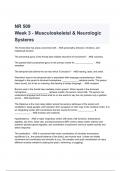NR 509
Week 3 - Musculoskeletal & Neurologic
Systems
The frontal lobe has areas concerned with - ANS personality, behavior, emotions, and
intellectual function.
The precentral gyrus of the frontal lobe initiates what kind of movement? - ANS voluntary
The parietal lobe's postcentral gyrus is the primary center for ______________. - ANS
sensation
The temporal lobe behind the ear has which 3 functions? - ANS hearing, taste, and smell.
Wernicke's area in the temporal lobe is associated with language comprehension. When
damaged in the person's dominant hemisphere, _____________ aphasia results. The person
hears sound, but it has no meaning, like hearing a foreign language. - ANS receptive
Broca's area in the frontal lobe mediates motor speech. When injured in the dominant
hemisphere, _________________ aphasia results; the person cannot talk. The person can
understand language and knows what he or she wants to say but can produce only a garbled
sound. - ANS expressive
The thalamus is the main relay station where the sensory pathways of the spinal cord,
cerebellum, basal ganglia, and brainstem form synapses on their way to the cerebral cortex. It is
an integrating center with connections that are crucial to human _____________ &
____________. - ANS emotion and creativity
Hypothalamus - ANS a major respiratory center with basic vital functions: temperature,
appetite, sex drive, heart rate, and blood pressure (BP) control; sleep center; anterior and
posterior pituitary gland regulator; and coordinator of autonomic nervous system activity and
stress response.
The cerebellum - ANS is concerned with motor coordination of voluntary movements,
equilibrium (i.e., the postural balance of the body), and muscle tone. It does not initiate
movement but coordinates and smooths it (e.g., the complex and quick coordination of many
different muscles needed in playing the piano, swimming, or juggling).
,What are the 3 parts of the brainstem? - ANS 1. Midbrain—The most anterior part of the
brainstem. It merges into the thalamus and hypothalamus. It contains many motor neurons and
tracts.
2. Pons—The enlarged area containing ascending sensory and descending motor tracts. It has
two respiratory centers (pneumotaxic and apneustic) that coordinate with the main respiratory
center in the medulla.
3. Medulla—The continuation of the spinal cord in the brain that contains all ascending and
descending fiber tracts. It has vital autonomic centers (respiration, heart, gastrointestinal
function) and nuclei for cranial nerves VIII through XII. Pyramidal decussation (crossing of the
motor fibers) occurs here (see p. 636).
Spinal Cord Location & Functions - ANS from the medulla to lumbar vertebrae L1-L2. Its white
matter is bundles of myelinated axons that form the main highway for ascending and
descending fiber tracts that connect the brain to the spinal nerves.
It mediates reflexes of posture control, urination, and pain response.
The spinothalamic tract contains sensory fibers that transmit which sensations? - ANS pain,
temperature, and crude or light touch (i.e., not precisely localized)
The Posterior (Dorsal) Columns' fibers conduct which sensations? - ANS position, vibration,
and finely localized touch
What is the term for being able to identify familiar objects by touch -without looking?
Which sensory pathway is used (anterolateral or spinothalamic tract or the posterior (dorsal)
columns)? - ANS stereognosis
Posterior (Dorsal) Columns
The sensory cortex is arranged in a specific pattern forming a corresponding "map" of the body
called the ___________________.
Which organs are not included? - ANS homunculus
the heart, liver, or spleen. You know you have one but you have no "felt image" of it, only
refeered pain
Cranial Nerve II—Optic Nerve: How to test the function of this CN? - ANS Test visual acuity and
visual fields by confrontation
, Using the ophthalmoscope, examine the ocular fundus to determine the color, size, and shape
of the optic disc
Cranial Nerves III, IV, and VI—Oculomotor, Trochlear, and Abducens Nerves
How to test the function of these CNs? - ANS Palpebral fissures (distance between eyelids) are
usually equal in width or nearly so.
Check pupils for size, regularity, equality, direct and consensual light reaction, and
accommodation
Assess extraocular movements by the cardinal positions of gaze
How do we test the Cranial Nerve V—Trigeminal Nerve? - ANS SENSORY:
With the person's eyes closed, test light touch sensation by touching a cotton wisp to these
designated areas on person's face: forehead, cheeks, and chin (Fig. 23-10). Ask the person to
say "Now" whenever the touch is felt. This tests all three divisions of the nerve: (1) ophthalmic,
(2) maxillary, and (3) mandibular.
MOTOR:
Assess the muscles of mastication by palpating the temporal and masseter muscles as the
person clenches the teeth (Fig. 23-9). Muscles should feel equally strong on both sides.
Try to separate the jaws by pushing down on the chin; normally you cannot.
How do we test the Cranial Nerve VII—Facial Nerve? - ANS Motor Function. Note mobility and
facial symmetry as the person responds to these requests: smile (Fig. 23-11), frown, close eyes
tightly (against your attempt to open them), lift eyebrows, show teeth, and puff cheeks (Fig.
23-12). Press the person's puffed cheeks in and note that the air should escape equally from
both sides.
How do we test the Cranial Nerves IX and X—Glossopharyngeal and Vagus Nerves? - ANS
Depress the tongue with a tongue blade and note pharyngeal movement as the person says
"ahhh" or yawns; the uvula and soft palate should rise in the midline, and the tonsillar pillars
should move medially.
Touch the posterior pharyngeal wall with a tongue blade and note the gag reflex. Also note that
the voice sounds smooth and not strained.
How do we test the Cranial Nerve XI—Spinal Accessory Nerve? - ANS Examine the
sternomastoid and trapezius muscles for equal size. Check equal strength by asking the person




